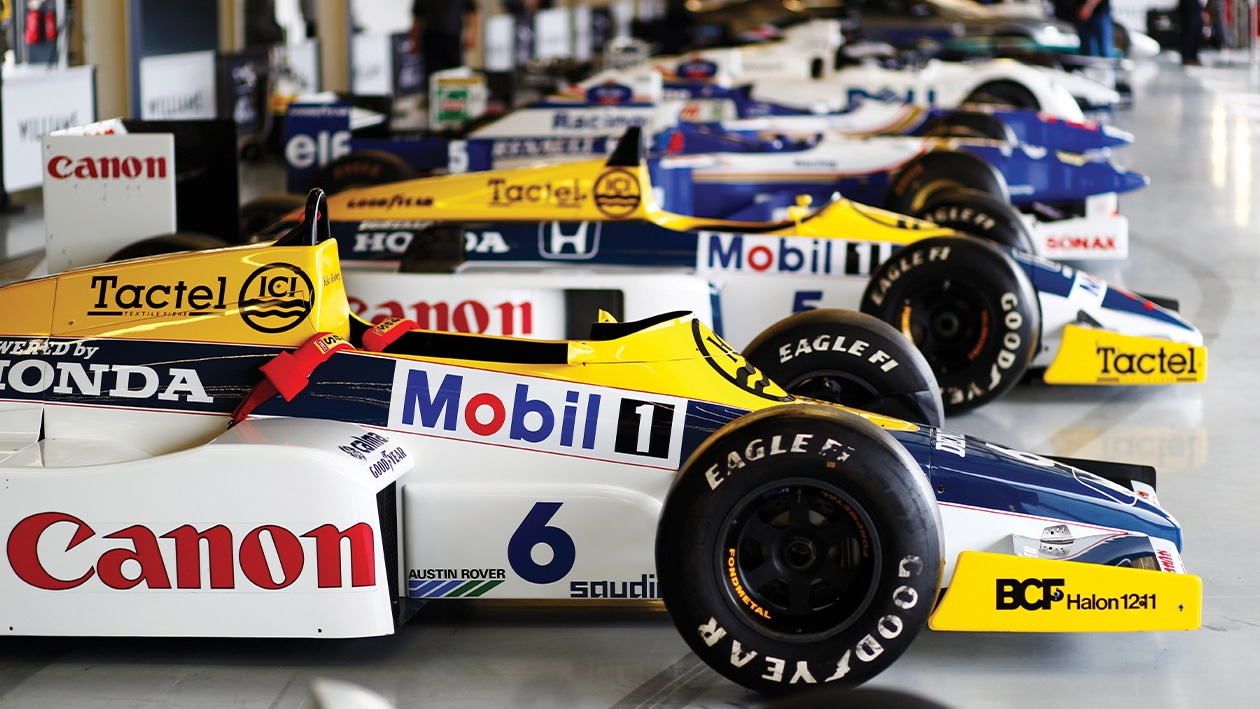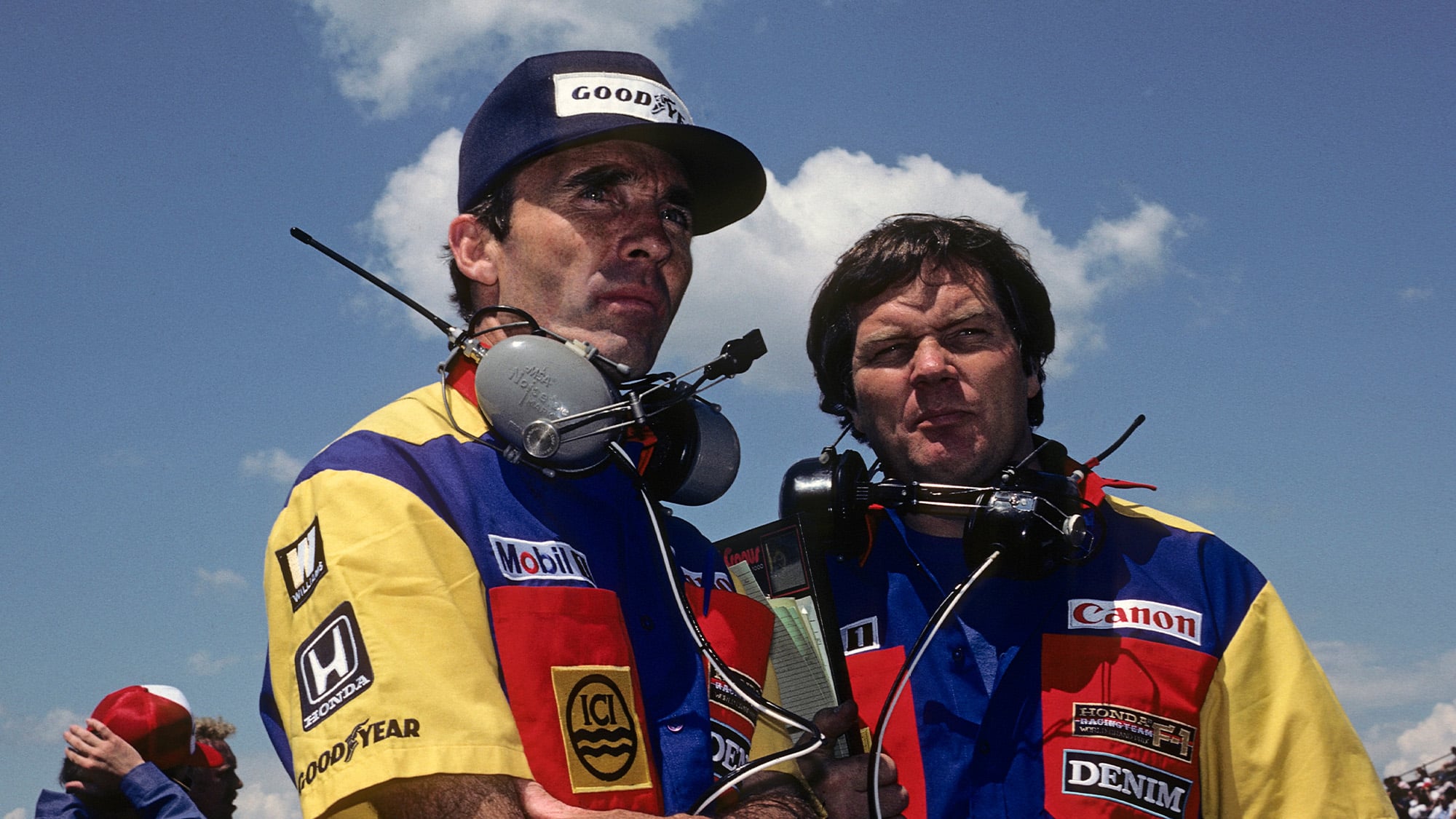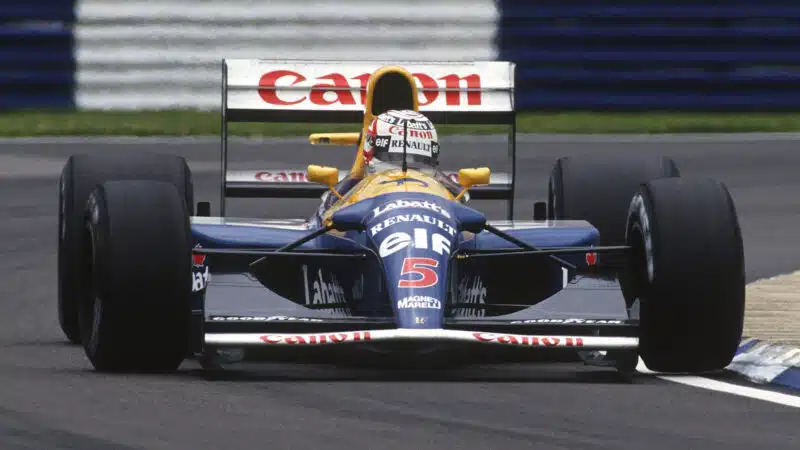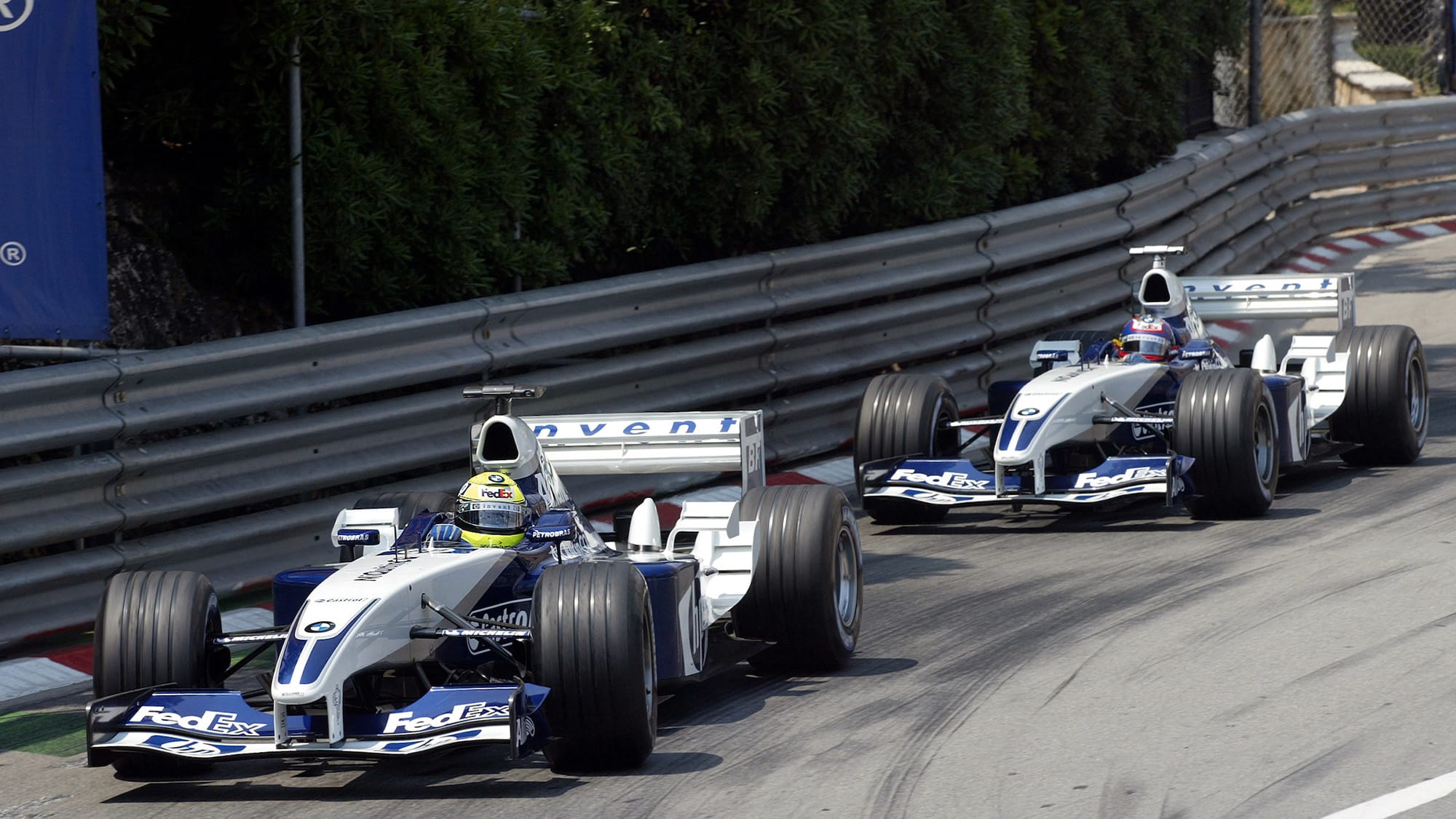Williams: The championship-winning F1 team that Frank built
Frank Williams turned an unpromising team into British racing royalty but, 40 years on, the future looks just as challenging. We speak to key figures from Williams’s past and those charged with bringing it success in the years to come

Forty years ago Frank Williams left the company he’d lost and started again – in an old carpet warehouse his friend Dave Brodie had found for him, with a second-hand March of dubious provenance and a struggling driver with a bit of sponsorship money behind him. It was Frank’s third attempt at establishing his own Formula 1 team (preceded by those of 1969-71 and ’72-76) and didn’t seem to have the obvious credentials of a world-beater. But that’s what it became, one of the greatest teams the sport has ever seen. Within two years, tenacious Frank’s little outfit had won its first Grand Prix, within three its first world titles. Another 14 championships would follow, six for drivers and eight for constructors.
The team’s heady days have become part of the sport’s fabric and imprinted upon our brains – Alan Jones aggressively hustling the FW07, the buccaneer Keke Rosberg improvising his way around a street circuit, a heat haze rising from the rear of a white, blue and yellow car, its Honda horsepower further suggested by massive Canon-emblazoned wings as Nigel Mansell and Nelson Piquet go at it, or the science-fiction grip of Mansell’s FW14B a few years later, the pluck of Damon Hill, the 0 on the nose emerging from the Suzuka gloom, Schumacher distant in his wake, Jacques Villeneuve going around the Ferrari’s outside at Estoril – and somewhere in the background a smiling Frank lost in the love of it all, a frowning Patrick Head at his side, conjuring up the engineering feat from which next chunk of lap time will come.
It was all there at Silverstone recently, iconic Williams machinery, iconic Williams people through the ages all briefly in one place acknowledging the anniversary of what in many ways is the royal family of British motor racing.
Snap-quotes of key figures give an impressionistic picture of the entity created by Frank and his partner Patrick.

Patrick Head (right) and Frank Williams (left) formed a title-winning bond through the 70s, 80s and 90s
Paul-Henri Cahier/Getty Images
PATRICK HEAD “Frank had been at a dinner somewhere and sat next to Guy Edwards, a driver with whom I’d done some work at Lola. Frank was saying I’m looking for a designer because I can’t find anyone decent and Guy said what don’t you try Patrick Head. My first meeting with Frank was at the Carlton Towers.
I turned up in a Renault 4 van painted in multi-colours by the previous owner – I’d paid £40 for it. I was in jeans and a woollen jersey, stinking of resin because I was building a boat in Surrey docks. Frank was there in his Dougie Heyward jacket, all smart. What the hell he thought seeing me, I can’t imagine… I was just thinking, ‘Well I’ll go and do some work for him until I’ve got enough to go back to the boat and carry on with that,’ because I’d run out of money. Not a brass farthing. In fact I started on November 25, 1975 and began working on the car he had, FW04, to improve it for the start of the season. On the second Monday I was called up from my Portakabin to the front office and Frank said, ‘This is Harvey Postlethwaite. I’ve sold the company to a man called Walter Wolf and Harvey is now chief designer.’ Which is what I thought I was! ‘You can either stay and work as number two to Harvey or here’s £500 and you can go.’ I needed a job more than I needed £500 so I stayed.
“But Harvey was a lovely bloke and I learned a lot by all the mistakes that were made on that one car [FW05]. At the beginning of the next year, about February ’77, I was running the Wolf test team and was at Kyalami testing with Jody Scheckter and three mechanics. Frank rang up and said, ‘Right, I’ve left. I’m starting again and I’m hoping you’re going to come and join me.’ So, big decision. I decided to join. I thought about it for a short while. I also got to make the boat – about 30 years later!”
NEIL OATLEY “I joined in late summer ’77 and was there until the end of ’84. I was employee number 13. Each department had one employee. Johnny Dumfries was the van driver and spares man. When I joined they were racing the March and Patrick had just started work on FW06 and the two of us effectively did that car together. Amazingly, we were able to design, build and test it by the end of the year.”
ROSS BRAWN “I went there as a machinist and eventually was the R&D guy. I recall in the early days the guys having a whip-round to pay the electricity bill. At tea breaks literally everyone was in the canteen – around one table. A wonderful team-building environment. That stuck with me throughout my career. I resigned from Williams at one stage because I’d gone to a test in Europe somewhere, me and three mechanics and the car, and the circuit owner said you didn’t pay the bill last year, you’re not coming in. So I’m on the other side of Europe trying to do this test and Frank didn’t have the money to pay the circuit and I was stranded. I said to Frank, ‘No, that’s it. I’m off.’ Luckily he and Patrick persuaded me to stay because if I’d left it would probably have been the worst decision I’d ever made. It was a fantastic education.”
FRANK DERNIE “When I joined late ’78 as the aerodynamicist, Patrick had pretty much drawn FW07. It had a sidepod that I inherited which was the best of the ones that had been tested and worked well. But I noticed in the tunnel the flow stalled at the back of the chassis alongside the end of the engine. So it was a case of instead of seeing it as a 2D profile, seeing it as a 3D area change in the diffuser. So we made changes alongside the engine and we even ended up with lumps on the underwing in local places. It was no longer a smooth curve. This kept the flow attached much further back and was one reason why the car worked so well.”
Williams was on its way. Clay Regazzoni winning the race one summer Silverstone Saturday, the wheat high in the field, Alan Jones taking his rivals apart over the following season, Union Jack flapping from the cockpit on his slow-down lap in Ricard after beating the Ligiers and Renaults. Into the turbo era with Honda. Then Frank’s crippling accident, even that not enough to keep him down as he guided his team from strength-to-strength, Mansell vs Piquet, no holds barred boys, just don’t crash into each other. A refusal to accept a Honda-nominated driver was so very Williams and the trigger for the end of that relationship. Then with Renault into the new naturally aspirated era, V10s wailing away, Patrick’s recruitment of Adrian Newey. Renault-Head-Newey – the rest didn’t stand a chance! Silverstone ’92 and a young data engineer watched his monitor nervously as Mansell in the active-ride FW14B dominated the race in front of his adoring fans.

Mansell and Williams – a winning partnership
Grand Prix Photo
PADDY LOWE “One of the issues that had emerged in the previous two races was the failure of the clutch position sensor. It wasn’t catastrophic to lose this immediately, but we lost track of clutch wear and that in turn would mean the gearshifts would start getting worse. We had very little data but I had one channel that came back, one eight-byte of data that would give me an error code and I had the table that told me what that code was. At about one-third distance this error code came up saying this sensor had failed. I kept it to myself – there was no point giving everyone misery for the next hour so I just sat there stressing out. The gearshifts did get worse but he got home. We’d have been lynched if he hadn’t!”
DAMON HILL “Frank was someone who was looking to imprint his own values onto the sport. He believed in very British ideals of playing it straight and winning it the right way. If you get beaten, don’t complain, put it behind you and do a better job next time. I went there as a test driver, not expecting to race. It was only after Nigel dropped his bombshell in Monza [’92] that he wasn’t re-signing and all the top guys were desperately trying to back-pedal out of their existing contracts that there came the realisation that there wasn’t really anyone else who could do it! Even then I had no expectation of being the lead driver because they had Alain Prost, then Ayrton Senna. Then Ayrton died and I was thrust into it. At Williams it was never about the driver, it was about the team and I get that now. Even before I won the [’96] championship Frank had already said he wasn’t going to employ me. He said I’ve got to do the right thing for the team. I understood the rules. That’s their approach so you know you’re just visiting. You know you’re not staying. But what an adventure.”
Jacques Villeneuve repeated Hill’s title success the following year. But that was 20 years ago – and remains the most recent Williams world championship. Which raises a couple of key questions.
Why Did The Success Tail Off?
Everyone else’s success tailed off too for a few years into the early part of this century as the Ferrari-Schumacher-Brawn axis completely redefined what the constituent parts of success were, with a level of investment and integration that finally leveraged up the full weight of Ferrari’s standing.
The partnership with BMW helped Williams briefly return to the front. It was the fastest car for much of 2003 and Juan Pablo Montoya was a title contender that year. But the fractious relationship between Williams and BMW came to a close after 2005. It has not had a works engine partner since, in an era when that has been essential for success.

Williams had the pace to win in 2003 — yet fell short due to animosity
Grand Prix Photo
As Frank Williams and Patrick Head have eased into their later years – and in Head’s case retired – the succession plan was not clear. This was complicated by happening at much the same time that the size and complexity of F1 teams was expanding incredibly quickly, fuelled by the car manufacturer budgets of the late ’90s and early 2000s.
Williams moved with the times in expanding but often not in thinking and culture. Without a clear and strong vision, relative strengths and weaknesses of departments have not always been well matched. The inter-departmental competition that inevitably follows a shortfall in results in some cases fed upon itself.
The financial situation of Williams became increasingly worrying as results dwindled for a team that still retained around 700 people. Investment in key areas suffered.
Where does Williams go from here?
Former Jaguar MD Mike O’Driscoll came on board, initially in a non-executive role but from 2013 as CEO. His first order of business was to work with deputy team principal Claire Williams to put the company on a solid financial footing. Two third places in the constructors’ championship and the recruitment of a new investor in the form of Laurence Stroll have taken the emergency out of the situation.
MIKE O’DRISCOLL “The first thing Claire and I focused on was stabilising the company financially. If you haven’t got a stable financial base you’re building on sand. We needed to stabilise it. We had a window of opportunity with the regulation change in 2014 that enabled us to be successful. 2014 and ’15 were very strong. But by ‘16 it was apparent that if we were going to challenge at the very front of the grid – which is our ambition – we needed to make further changes. We’re delighted we persuaded Paddy Lowe to join us as chief technical officer, and Dirk de Beer as head of aero. With them and a strong design and development group, we feel we have the ability to get Williams back to the front. Until we’ve done that it’s just work in progress.”
PADDY LOWE “I arrived back here only a few months ago. There are 64 people still here from when I left 24 years ago. I found a lot of good stuff, a lot of good people doing some very interesting things that I’ve not seen in other places. That’s very encouraging. But I’m painfully conscious there’s a two-second gap to the front. That gets you going. There’s a lot to do, but most of the things we’re missing are reasonably clear. But you do come up against what is the most extreme imbalance of resources between teams in the sport’s history.
“Closing that gap will require us to operate incredibly efficiently. But we don’t have an attitude of ‘it’s not possible’. From there we hope to do one better and use that as the platform to do better again; that’s how you succeed on merit. There’s no free ticket to get there in one jump. But the road is towards victory.”
The first part of problem solving is recognising there’s a problem. But that recognition must come from those empowered to do something about it. O’Driscoll has been that person on the financial side, but on the technical side it is now Lowe’s task to change what in many ways is an old-fashioned F1 team. He seems very aware of that. “This has been a great day to celebrate the team’s history but for me it’s about looking forward. It’s about what we do today and in the future.
It’s great legacy but we need to build a new one.”
Nigel is readers’ choice
Patrick Head presents Nigel Mansell with MS Hall of Fame award
PH I think it’s still the case today that you see the characters of the drivers, but it was probably more so 20 years ago. Nigel was always interesting, never dull. I remember at Montréal when we started to get our act together with Honda and we started to be serious contenders, towards the end of ’85. I sometimes had to be quite tough with Nigel over the radio. Nigel was running about three-and-a-half bar boost and was either in the lead or close to it; in the lead I think…
NM I was in the lead.
PH We were running a little behind on fuel consumption, so I said ‘Nigel, turn boost to 3.4.’ There was a long silence … then he came on and said ‘I don’t want to turn the boost down!’
So I said ‘Nigel, turn the effing boost down to 3.4!’ There was a bit of a wait and then Honda told us that, yes, he had turned the boost down to 3.4 but being typically Nigel, he wasn’t just going to do that. He had to show us that he was faster on the next lap with 3.4 bar boost than he had been on the lap before with 3.5. So he did one very quick lap, then settled down to the speed that he was doing before.
Then in order to try and tell us that he was bored in the lead of the race, I suddenly started hearing [in a Brummie accent] ‘Today’s the day the teddy bears have their picnic. Picnic time for teddy bears …’ Meanwhile he was lapping at flat-out speed around the Montréal track. He was trying to tell us, ‘I can do this – easy!’
NM It was never easy! Patrick was fantastic because I used to go off occasionally and damage the car and he sat me down one day and said ‘Please, please, if you can do your best not to bend anything because it does set the programme back a little bit…’
Do you remember when I came into the pitlane in Adelaide real quick practising before the race? I had the biggest shunt coming into the pits. I think 188mph was the quickest we exited the pits. It was quite dangerous, wasn’t it?
PH I had to jump out the way quite a few times! [But] I have to say, this is hugely well deserved. Many, many thousands of Motor Sport readers have voted you into this position. It’s very well deserved.
NM On a serious note, ladies and gentlemen: [my thanks to] Motor Sport, all the fans who have voted, all the sponsors, obviously Sir Frank, Sir Patrick, the late Colin Chapman, but there’s one special person in the room who has believed in me since 16 years of age. That’s my dear lady wife Roseanne who is still with us now and, my goodness me, what a medal that is.
PH Nigel was not always the easiest of people. But when he put the visor down and went out on the track, he was on it 100 per cent and more. It sharpened the whole team up. We all understood what he was there for, and we were all happy to play our part helping to achieve it. I think Graham Hill suffered by being considered the gritty trier to the talented Jim Clark; without trying to do Clark down, I think Graham was actually very talented as well. Somehow a few journalists seem to give the same tack to Nigel, but I’d put Nigel right with Alain Prost and Ayrton Senna. I never, ever had any thought that if anybody else was in the car, it would go quicker – in fact the reverse.
NM Any chance of a back-dated pay rise?
This is an edited transcript from the awards presentation. Watch the full exchange at www.motorsportmagazine.com/hof
Scalextric Williams Race set
£139.99
Put Williams back on the top step of the podium with the latest Scalextric F1 race set. Battle with two Williams FW45 cars — one with Gulf livery — on a track with four layout options and lap counter.

